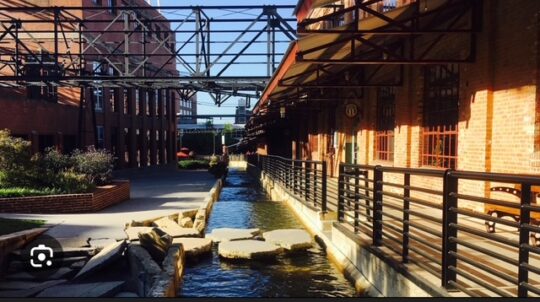Press is one of many restaurants on The American Tobacco Campus, a collection of historic tobacco warehouses that tells one of the most compelling urban renewal stories in America. The American Tobacco Campus has transformed from abandoned industrial ruins into a thriving destination that proves old buildings can have vibrant new lives.
From Powerhouse to Empty Shells
These buildings once housed The American Tobacco Company, formed in 1890 by James Buchanan Duke. For decades, this massive complex employed thousands of workers and produced millions of cigarettes, making it synonymous with Durham itself. The factory whistles marked the city’s rhythm, and the wealth generated built Durham’s institutions.




But as the tobacco industry declined, the buildings fell silent. By the late 20th century, they sat empty and deteriorating—massive brick monuments to a fading industrial era.
The $200 Million Gamble
In the early 2000s, Capitol Broadcasting Company purchased the complex with an ambitious vision: transform these industrial relics into a mixed-use destination that would anchor downtown Durham’s revitalization.

The renovation was massive, but rather than gutting the buildings, developers embraced their industrial character. They preserved brick exteriors, exposed original wooden beams, maintained large factory windows, and kept authentic details. Original tobacco signage remains visible. The Lucky Strike water tower still stands. Industrial elements have been preserved as art.
The result is architecture that’s honest about its past while thoroughly modern in function.





What’s There Now
Today, the campus is a thriving ecosystem:
Offices: Thousands of employees work in renovated factory floors with exposed brick, soaring ceilings, and massive windows—the kind of character-rich space modern companies crave.




Dining: From casual eateries to upscale restaurants, craft breweries to cocktail bars, the dining scene is exceptional and diverse.

The Plaza: The sprawling central plaza serves as Durham’s outdoor living room—hosting concerts, farmers markets, movies, and countless events. On any day you’ll find office workers, families, couples, and visitors gathering in this genuinely welcoming public space.

Durham Bulls Connection: A pedestrian bridge links the campus directly to Durham Bulls Athletic Park, creating synergy between the two destinations.
More Than Just Buildings
The American Tobacco Campus has become a nationally recognized model for adaptive reuse.









What makes it work?
• Authenticity: It celebrates rather than hides the industrial past
• Mixed use: Activity throughout the day and week
• Public access: Genuinely welcoming despite private ownership
• Quality: Details matter, and the renovation was done right

The campus was catalytic in Durham’s downtown revival, encouraging residential development, new restaurants, and other investments. It proved people wanted to live, work, and play in downtown Durham.

Visit Anytime
The campus is open to the public and free to explore. Check for event schedules—there’s often something happening—but even without events, it’s worth wandering through to appreciate the architecture and atmosphere.
Parking is available, and the campus is walkable from other downtown Durham destinations.
Final Thoughts
The American Tobacco Campus represents the possibility of honoring the past while building the future. These buildings that once produced cigarettes now produce ideas, connections, and community. It’s a rare place where history and vitality coexist so visibly.
For visitors, it’s essential Durham—telling the city’s story of industrial past, decline, and remarkable rebirth. For residents, it’s become part of daily life—a place to work, eat, gather, and celebrate.
Bottom line: The American Tobacco Campus is more than successful real estate development. It’s a symbol of Durham’s resilience, a model for adaptive reuse, and a genuine community gathering place. Whether you’re exploring Durham for the first time or you’ve lived here for years, these beautiful brick buildings capture something essential about Bull City—its history, its present, and its future, all in one remarkable place.








